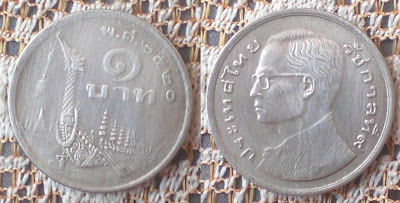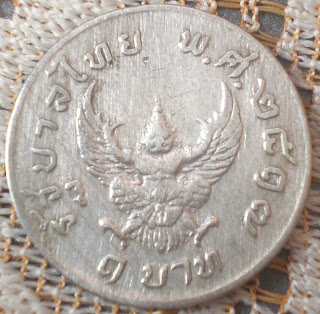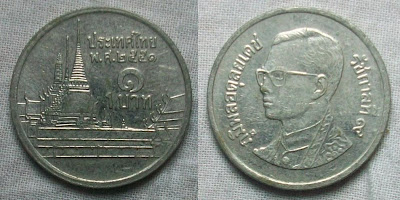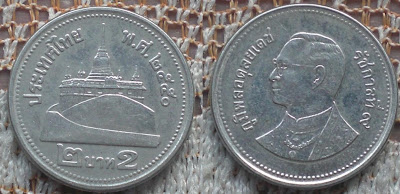1 Baht, 2008
1 Baht, 1962

 This is an old one baht coin. In this one we have the coat of arms of Siam(the then name of the now Thailand) in traditional heraldic style. This one was designed during the reign of King Chulalongkorn(Rama V).
This is an old one baht coin. In this one we have the coat of arms of Siam(the then name of the now Thailand) in traditional heraldic style. This one was designed during the reign of King Chulalongkorn(Rama V).The description of the coat of arms may be a little hard to understand but here it is:
The Shield, is divided into three quadrants. The first quadrant depicts a mythological three-headed white elephant, or Erawan (in Hindu mythology called Airavata), the vehicle of the god Indra, the creature is set on a yellow field. This quadrant represents the Kingdom of Siam and the Thai heartland, the three heads of the elephant represents the northern, central and southern Siam. The lower left quadrant depicts a white elephant in front of a red field. This quadrant represents the Laotian suzerainty (the symbol comes for its native name "Lan Xang", land of the million elephants.). The lower lower right quadrant depicts two crossed krises (one with and one without a scabbard) on a pink field, this represents the Malay suzerainty to the south.
Above the shield is the symbol representing the Chakri Dynasty, a disc and a trident (chakra and trisula). The shield is then surrounded by the chain of the Ancient and Auspicious Order of the Nine Gems (representing Buddhism) with a chain and pendant from the Most Illustrious Order of Chula Chom Klao (featuring a portrait of King Chulalongkorn).
The motto is written in gold on a red and green ribbon at the bottom of the arms. The motto, which is written in the Pali language in Thai script reads: "Sabbesam Sanghabhutānam Sāmaggī Vuḍḍhi Sādhiga.", translated as:"Unity brings happiness". The supporters of the arms are two mythical creatures, clad in regalia. To the left of the shield (dexter) is an elephant lion (a lion with a trunk) or a 'Kojasiha'. To the right of the shield (sinister) is a king of the lions the 'Rajasiha'. The two supporters represents the two ancient departments of Kalahom (Kojasiha) and Mahatthai (Rajasiha).
One baht, 1977

The reverse shows the Suphannahong, with Wat Aran temple(don't ask me what the heck that is!) . The date reads 2520 BE, which converts to 1977 AD.
Chao Phraya, the river of Kings, has been the lifeblood of the people who live on its banks. For centuries the great river has witnessed the grandeur and wealth of Thailand. Evidence of this grandeur can be seen in the artistic marvel found on the grand royal barges that have been passing along this river since the Ayutthaya Period. Among them, Suphannahongs Royal Barge is the most prominent and well known among Thais and foreigners.
The title "Suphannahongs" first appeared during the reign of King Mahachakrapadi between 1548-1568. According to the legend about Thai Battleships, by Krom Phraya Rachanubharp, the ship was built during the reign of King Rama I and known as Sri Suphannahongs Ship. The name was changed several times under different sovereign power, but it was during the reign of King Rama VI that the title Suphannahongs was adopted and has remained unchanged to this time.
The famous Wat Aran , perhaps better known as the Temple of the Dawn, is one of the best known landmarks and one of the most published images of Bangkok. It consists of a massive elongated prang (Khmer-style tower), and is surrounded by four smaller prangs. The prang is described by the Tourism Authority of Thailand as 104m high, while most other sources quote figures around 80-85m. It is decorated by bits of porcelain which had previously been used as ballast by boats coming to Bangkok from China, a hallmark of the reign of King Rama III. The Wat had a brief period as host of the celebrated Emerald Buddha, which now resides in nearby Wat Phra Kaew.
The Wat really looks better from a distance than close up, and you're not missing out too much even if you only view from across the river. The grounds are fairly pleasant and peaceful though, with good murals and a main Buddha image supposedly designed by King Rama II. The mythical guardians here are also quite impressive, though very similiar to those at Wat Phra Kaew.
It is possible to walk a limited way up the (very steep) stairs of the main prang, which gives a reasonable view of the Chao Phraya river.
Thailand one baht, 1974
 Reverse shows the mythical creature garuda, and the coin is struck in copper-nickel. The date reads 2517 BE, which when converted gives the year 1974. The above picture of garuda is also the coat of arms of Thailand.
Reverse shows the mythical creature garuda, and the coin is struck in copper-nickel. The date reads 2517 BE, which when converted gives the year 1974. The above picture of garuda is also the coat of arms of Thailand. The Obverse shows Rama IX(Phra Maha Bhumifhol Adulyadei) , who came to power in 1946.
The Obverse shows Rama IX(Phra Maha Bhumifhol Adulyadei) , who came to power in 1946.




I have one coin
ReplyDeletemdnuru14296@gmail.com
ReplyDelete